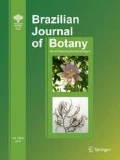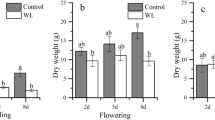Abstract
The latex dilution reaction during the tapping flow course has been well documented and associated with the facilitation of tapping latex flow. However, its underlying mechanism has not experimentally examined. The latex total solid content, osmotic potential and phloem turgor pressure change during the tapping flow course were simultaneously measured to investigate the cause of water movement during the tapping flow course. It was found that there are three different stages for the laticifer water equilibrium during the tapping flow course. The tapping-induced rapid turgor pressure drop is the cause of the first stage water influx into laticifers, while osmoregulation prevails during water exchange in the second and third stages of tapping flow. Meanwhile, aquaporin expressions were, for the first time, investigated during the tapping flow course. The rapid transcript up-regulation of HbPIP1, HbPIP2;1 and HbPIP2;3 contributes to the latex dilution reaction. However, their activity gating cannot be ruled out. Ethrel stimulation can significantly dilute the corresponding latex fractions during the tapping flow course due to its up-regulations of HbPIP1, HbPIP2;1 and HbPIP2;3. Nevertheless, the latex dilution reaction pattern for the Ethrel treated trees did not change, except for a lower degree of dilution compared with the un-treated trees. All these results suggest that both phloem turgor pressure and aquaporins are involved in the latex dilution reaction during the tapping flow course.





Similar content being viewed by others
References
An F, Cahill D, Rookes J, Lin W, Kong L (2014a) Real-time measurement of phloem turgor pressure in Hevea brasiliensis with a modified cell pressure probe. Bot Stud 55(1):19
An F, Lin W, Cahill D, Rookes J, Kong L (2014b) Variation of phloem turgor pressure in Hevea brasiliensis: an implication for latex yield and tapping system optimization. Ind Crop Prod 58:182–187
Arisz WH (1928) Physiology van het tappen. Arch Rubbercult 12:220–241
Bisson MA, Beilby MJ (2002) The transport systems of Ventricaria ventricosa: hypotonic and hypertonic turgor regulation. J Membrane Biol 190:43–56
Buttery BR, Boatman SG (1964) Turgor pressures in phloem: measurements on Hevea latex. Science 145:285–286
Buttery BR, Boatman SG (1966) Manometric measurement of turgor pressures in laticiferous phloem tissues. J Exp Bot 17:283–296
Buttery BR, Boatman SG (1967) Effects of tapping, wounding, and growth regulators on turgor pressure in Hevea brasiliensis Muell Arg. J Exp Bot 18:644–659
Chaumont F, Moshelion M, Daniels MJ (2005) Regulation of plant aquaporin activity. Biol Cell 97:749–764
D’Auzac J, Jacob JL, Chrestin H (1989) Physiology of rubber tree latex. CRC Press, Boca Raton
D’Auzac J, Jacob JL, Prevot JC, Clément A, Gallois R, Crestin H, Lacote R, Pujade-Renaud V, Gohet E (1997) The regulation of cis-polyisoprene production (natural rubber) from Hevea brasiliensis. Recent Res Dev Plant Physiol 1:273–332
De Faÿ E, Sanier C, Hebant C (1989) The distribution of plasmodesmata in the phloem of Hevea brasiliensis in relation to laticifer loading. Protoplasma 149:155–162
De Jonge P (1955) Stimulation of yield in Hevea brasiliensis. III: further observations on the effects of yield stimulants. J Rubb Res Inst Malays 14:383–406
De Schepper V, De Swaef T, Bauweraerts I, Steppe K (2013) Phloem transport: a review of mechanisms and controls. J Exp Bot 64:4839–4850
Ferrand M (1941) Observations sur les variations de la concentration du latex in situ par la micromethode de la goutte du latex. I.N.E.A.C. Serie Scientifique 22:1–33
Frey-Wyssling A (1932) Investigations on the dilution reaction and the movement of the latex of Hevea brasiliensis during tapping. Arch Rubbercult 16:285–327
Gooding E (1952a) Studies in the physiology of latex II: latex flow on tapping Hevea-brasiliensis- associated changes in trunk diameter and latex concentration. New Phytol 51:11–29
Gooding E (1952b) Studies in the physiology of latex III: effects of various factors on the concentration of latex of Hevea brasiliensis. New Phytolt 51:139–153
Gould N, Minchin PEH, Thorpe MR (2004) Direct measurements of sieve element hydrostatic pressure reveal strong regulation after pathway blockage. Funct Plant Biol 31:987–993
Gould N, Thorpe MR, Koroleva O, Minchin PEH (2005) Phloem hydrostatic pressure relates to solute loading rate: a direct test of the Münch hypothesis. Funct Plant Biol 32:1019–1026
Hachez C, Chaumont F (2010) Aquaporins: a family of highly regulated multifunctional channels. In Mips and Their Role in the Exchange of Metalloids, pp 1–18
Hall SM, Milburn JA (1973) Phloem transport in Ricinus: its dependence on the water balance of the tissues. Planta 109:1–10
Hill AE, Shachar-Hill B, Shachar-Hill Y (2004) What are aquaporins for? J Membrane Biol 197:1–32
Kaldenhoff R, Fischer M (2006) Aquaporins in plants. Acta Physiol 187:169–176
Knoblauch M, Oparka K (2012) The structure of the phloem: still more questions than answers. Plant J 70:147–156
Knoblauch M, Peters WS (2010) Münch, morphology, microfluidics: our structural problem with the phloem. Plant, Cell Environ 33:1439–1452
Li H, Qin Y, Xiao X, Tang C (2011) Screening of valid reference genes for real-time RT-PCR data normalization in Hevea brasiliensis and expression validation of a sucrose transporter gene HbSUT3. Plant Sci 181:132–139
Lustine J, Resing WL, Chun CK (1967) La stimulation de l’Hévea par les acides chlorophénoxyacétiques et son influence sur l’aire drainée. Rev Gen Caout Plast 44:635–641
Milburn JA (1974) Phloem transport in Ricinus: concentration gradients between source and sink. Planta 117:303–319
Milburn JA, Ranasinghe MS (1996) A comparison of methods for studying pressure and solute potentials in xylem and also in phloem laticifers of Hevea brasiliensis. J Exp Bot 47:135–143
Pakianathan SW, Boatman SG, Taysum DH (1966) Particle aggregation following dilution of Hevea latex: a possible mechanism for the closure of latex vessels after tapping. J Rubb Res Inst Malays 19:259–271
Patrick JW, Zhang W, Tyerman SD, Offler CE, Walker NA (2001) Role of membrane transport in phloem translocation of assimilates and water. Funct Plant Biol 28:697–709
Priyadarshan PM (2011) Biology of Hevea rubber. CAB International, Wallingford
Riches JP, Gooding E (1952) Studies in the physiology of latex I: latex flow on tapping theoretical considerations. New Phytol 51:1–10
Tang C, Huang D, Yang J, Liu S, Sakr S, Li H, Zhou Y, Qin Y (2010) The sucrose transporter HbSUT3 plays an active role in sucrose loading to laticifer and rubber productivity in exploited trees of Hevea brasiliensis (para rubber tree). Plant, Cell Environ 33:1708–1720
Thompson MV (2006) Phloem: the long and the short of it. Trend Plant Sci 11:26–32
Tungngoen K, Kongsawadworakul P, Viboonjun U, Katsuhara M, Brunel N, Sakr S, Narangajavana J, Chrestin H (2009) Involvement of HbPIP2;1 and HbTIP1;1 aquaporins in ethylene stimulation of latex yield through regulation of water exchanges between inner liber and latex cells in Hevea brasiliensis. Plant Physiol 151:843–856
Tungngoen K, Viboonjun U, Kongsawadworakul P, Katsuhara M, Julien J, Sakr S, Chrestin H, Narangajavana J (2011) Hormonal treatment of the bark of rubber trees (Hevea brasiliensis) increases latex yield through latex dilution in relation with the differential expression of two aquaporin genes. J Plant Physiol 168:253–262
Wan X, Steudle E, Hartung W (2004) Gating of water channels (aquaporins) in cortical cells of young corn roots by mechanical stimuli (pressure pulses): effects of ABA and of HgCl2. J Exp Bot 55:411–422
Wang J, An F, Cai X, Zou Z, Zhang W, Lin W (2014) Function characterization and expression analysis of aquaporins (HbPIP1 and HbPIP2) in Hevea brasiliensis. Scientia Silvae Sinicae 50:69–75
Xiao ZY (2005) Protocols for latex physiological diagnosis measurement of Hevea. Chin J Trop Agri Sci 25:29–31
Yeang HY (2005) The kinetics of latex flow from the rubber tree in relation to latex vessel plugging and turgor pressure. J Rubber Res 8:160–181
Zimmermann MH (1957) Translocation of organic substances in trees II: on the translocation mechanism in the phloem of white ash (Fraxinus americana L.). Plant Physiol 32:399–404
Zimmermann MH (1962) Translocation of organic substances in trees V: experimental double interruption of phloem in white ash (Fraxinus americana L.). Plant Physiol 37:527–530
Acknowledgments
This work was supported by grants from the National Natural Science Foundation of China (31100460), the Earmarked Fund for China Agriculture Research System (CARS-34) and the Natural Science Foundation of Hainan Province (809029). The primary author, FA, thanks Deakin University for the prevision of Ph.D scholarship.
Conflict of interest
The authors have no conflict of interest to declare.
Author information
Authors and Affiliations
Corresponding authors
Additional information
Feng An and Xiuqing Cai have contributed equally to this work.
Rights and permissions
About this article
Cite this article
An, F., Cai, X., Rookes, J. et al. Latex dilution reaction during the tapping flow course of Hevea brasiliensis and the effect of Ethrel stimulation. Braz. J. Bot 38, 211–221 (2015). https://doi.org/10.1007/s40415-014-0125-7
Received:
Accepted:
Published:
Issue Date:
DOI: https://doi.org/10.1007/s40415-014-0125-7



